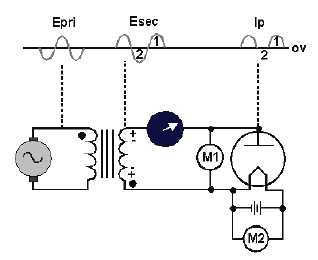1-6
You have all of the facts available that Fleming had. Can you give an explanation of why the diode
cuts off current when the plate is negative?
Let’s put the facts together. The filament is hot and electrons boil from its surface. Because the
filament is the only heated element in the diode, it is the ONLY source of electrons within the space
between filament and plate. However, because the plate is NEGATIVE and the electrons are
NEGATIVE, the electrons are repelled back to the filament. Remember that LIKE CHARGES REPEL.
If electrons cannot flow across the space, then no electrons can flow anywhere in the plate circuit. The
ammeter therefore indicates ZERO.
It might seem to you that electrons flow from the negative plate to the positive filament under these
conditions. This is NOT the case. Remember that it takes a heated element to emit electrons and that the
filament is the only heated element in the diode. The plate is cold. Therefore, electrons cannot leave the
plate, and plate-to-filament current cannot exist.
The following is a summary of diode operation as we have covered it to this point:
Assume that all parts of the circuit are operable and connected.
PLATE CURRENT FLOWS WHEN THE PLATE IS POSITIVE.
PLATE CURRENT IS CUT OFF WHEN THE PLATE IS NEGATIVE.
PLATE CURRENT FLOWS ONLY IN ONE DIRECTION-FROM THE FILAMENT TO
THE PLATE.
Measuring Diode Voltages
As you know, it is impossible to have a voltage at one point, because voltage is defined as a
DIFFERENCE of POTENTIAL between two points. In our explanation above we referred to plate
voltage. To be exactly right, we should refer to plate voltage as the VOLTAGE BETWEEN PLATE
and FILAMENT. Plate voltages, and others that you will learn about soon, are often referred to as if they
appear at one point. This should not confuse you if you remember your definition of voltage and realize
that voltage is always measured between two points. M1 and M2 in figure 1-5 measure plate voltage and
filament voltage, respectively.
Figure 1-5.—Alternating voltage on the plate.

